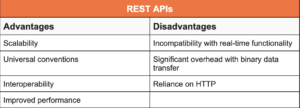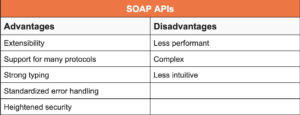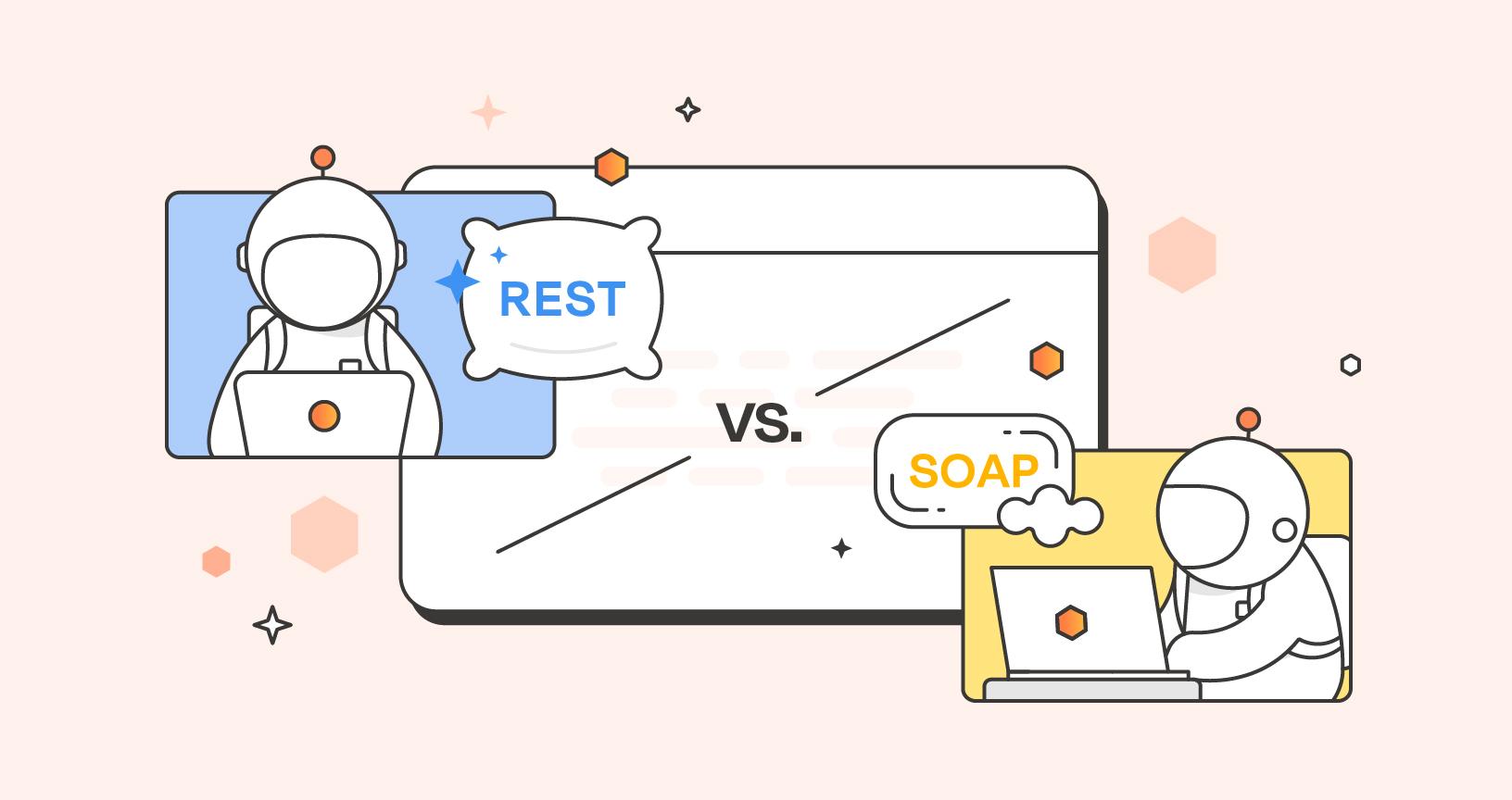REST vs. SOAP APIs

This is a guest post written by Chris Staudinger, co-founder and COO of levelupcoding.co, a company that offers visual learning to simplify software engineering.
Software engineering practices are constantly evolving, but there are a few key technologies that have had a tremendous and sustained impact on today’s digital world. Two notable examples are Representational State Transfer (REST) and Simple Object Access Protocol (SOAP), which are both used for API development and communication. But what are the differences between REST and SOAP, and which use cases does each one support?
In this post, we’ll review the distinguishing features of both approaches—and discuss their advantages and disadvantages.
Related: The different types of APIs
Difference between REST and SOAP
A RESTful approach is the better option for applications that require CRUD operations (create, read, update, and delete). A good example is a content management system (CMS), which uses standard HTTP methods—POST, GET, PUT, and DELETE—to create and maintain entities. Additionally, REST’s ability to cache responses makes it a good fit for high-demand applications where certain requests are made frequently. Finally, REST is very popular, and companies that use a RESTful design for public APIs are able to cater to a wider range of developers who have dealt with REST before.
On the other hand, systems that have strict API security requirements and regulations may benefit from a SOAP-based approach because of its built-in security measures. For instance, its support for WS-Security and strongly-typed contracts make SOAP a better fit for systems that send and receive highly sensitive data, such as financial and healthcare information.
Benefits of REST APIs
Related: What is a REST API?
Designing scalable and maintainable web services can be difficult, which is where REST comes in handy. REST is an architectural style that provides a set of guidelines, conventions, and best practices for developing well-designed networked applications.
APIs that are designed according to REST principles are referred to as “RESTful APIs,” and they have the following features in common:
- Statelessness: The server shouldnot need to store any information about the client’s state. Rather than storing session information, a client should provide all the necessary details in its request.
- Separation of concerns: The client and server should be properly decoupled from each other, which allows each one to evolve independently.
- Layered architecture: Software architecture should be split into layers with their own distinct purpose, which helps keep the system modular and maintainable.
- Cache support: Responses can be cached on the client to improve an application’s performance and remove the need to re-process repeated requests.
- Consistent interface: HTTP methods like GET, POST, and DELETE help make interactions between clients and servers simple and consistent.
- Emphasis on resources: RESTful APIs are resource-based, rather than method-based or function-based. A resource can be an object, entity, or data within a system. Resources are uniquely identified using a Uniform Resource Identifier (URI), and HTTP methods are used to perform CRUD operations (create, read, update, delete) on them.
- Support for standard media types: Resources are represented using standard media types, such as JSON, XML, or plain text. Clients can request that servers deliver a response in their preferred media type.

Advantages of REST
REST provides a straightforward approach to seamless communication between clients and servers. Following the basic principles of this architectural style can lead to a variety of benefits, including:
- Scalability: The stateless nature of REST APIs means that the session state does not need to be shared or synchronized across various instances, which makes horizontal scaling easier. As a result, you can add additional servers during peak traffic without any disruption to functionality or risk of losing any important session state.
- Universal conventions: Applications that follow standardized, universal conventions provide a much better developer experience and improve the system’s maintainability. Having a consistent interface also improves interoperability and makes it easier for various systems to communicate with one another.
- Interoperability: Any client that supports HTTP can use a RESTful API, regardless of its platform or programming language.
- Improved performance: Latency and server load can be drastically reduced by caching server responses. This leads to better performance and user experience, as well as cost savings from minimized computational overhead.
Disadvantages of REST
Although REST is the most popular approach for designing APIs, it is not without drawbacks. An in-depth understanding of the disadvantages you may find with a RESTful API will help you decide whether this approach suits your application’s needs. Here are some challenges of REST that should be taken into consideration:
- Incompatibility with real-time functionality: RESTful APIs are not the right fit for applications that require live data because of their request-response-based approach. In a request-response model, the client must send a request to the server and wait for the server’s response, which is inherently inefficient for real-time applications.
- Significant overhead with binary data transfer: When large binary files, like images or video, are sent via a RESTful API, they must be encoded and decoded. This overhead can cause an increase in bandwidth consumption and slower transfers, which introduces a risk of timeouts. An alternative protocol and design would be better suited for this use case.
- Reliance on HTTP: REST was designed with HTTP in mind, which is why it is typically implemented using HTTP. Its natural alignment with HTTP may restrict the range of devices to which a RESTful API can cater.
Although REST is a highly popular approach for web service communication, it is important to recognize that there are other options available. One alternative is Simple Object Access Protocol, also known as SOAP.
Benefits of SOAP APIs
Related: What is a SOAP API?
Simple Object Access Protocol (SOAP) is a protocol for exchanging information between systems over the Internet, using XML as its message format. Unlike REST, SOAP follows a very strict structure. It uses standardized contracts such as Web Service Definition Language (WSDL) to specify the functionalities of an API.

Advantages of SOAP
Despite its waning popularity, SOAP offers some benefits that REST does not, such as:
- Extensibility: Developers can extend and add functionality as needed by using XML namespaces and custom header elements.
- Support for many protocols: Unlike REST, which is more commonly used with the HTTP protocol, SOAP can be used with a wide range of protocols such as HTTP, SMPT, and even specialized protocols like Microsoft Message Queuing (MSMQ).
- Strong typing: The XML schema is used to define the structure of messages and their data types. This helps improve data validation, detect errors, and reduce the potential for communication errors.
- Standardized error handling: SOAP uses a fault element to communicate errors that occur during message processing. A standardized approach to error handling allows different systems to parse and handle errors in a consistent manner.
- Heightened security: SOAP has built-in security standards, such as WS-Security, that ensure messages can be sent and received securely. It also supports security measures such as digital signatures, tokens, and encryption to ensure the integrity and confidentiality of messages.
Disadvantages of SOAP
SOAP has a lot of benefits, but it also has its own unique set of disadvantages. For instance, SOAP APIs are:
- Less performant: SOAP messages can be quite large due to their verbose XML-based structure, which can lead to greater bandwidth usage and slower performance.
- Complex: SOAP can introduce complexity into a system due to its strongly typed and extensible nature. REST offers a far simpler approach.
- Less intuitive: SOAP is centered around actions and methods, which many find less intuitive than REST’s resource-based approach.
The bottom line
Related: Use the REST API Basics Template
REST and SOAP both have unique benefits and drawbacks that affect their suitability for various use cases.
Software development often involves choosing between several possible solutions, which is why it’s important to understand the advantages and disadvantages of the available options. REST and SOAP approach API development very differently, which creates a clear distinction between the use cases for which each one is suited. By carefully considering the application’s objective, developers will be able to make an informed decision on which approach will provide the best end-user experience.

Good examples and simple explanation. Thanks